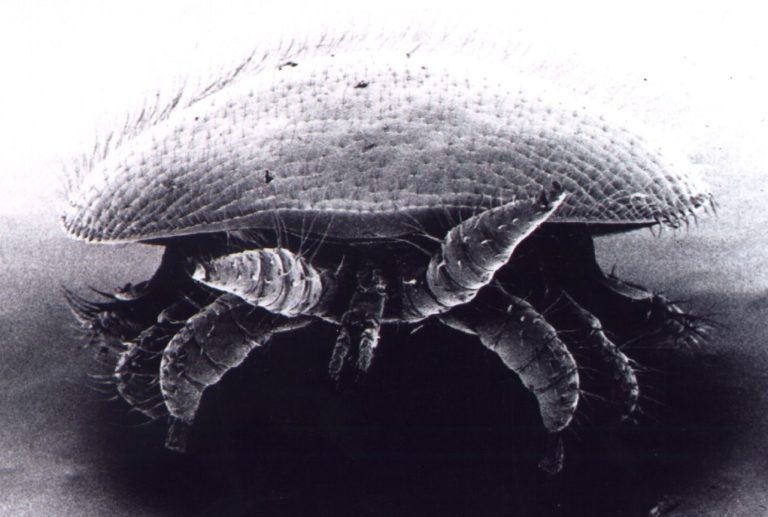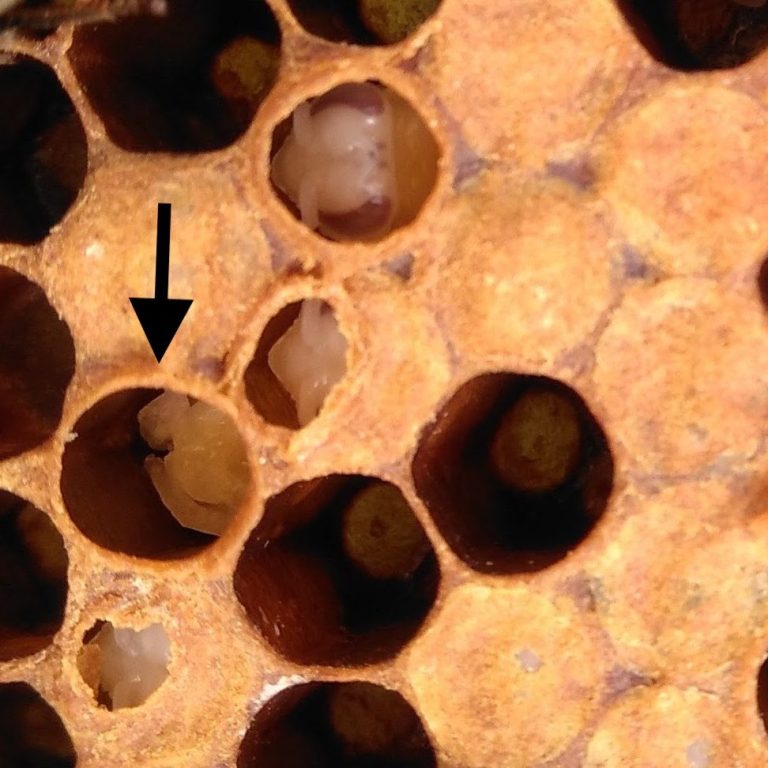A Long-term solution to the Varroa problem
Recent research can now explain how a small number of beekeepers managed to keep bees after stopping Varroa treatment 10 or more years ago. Combining the experience of these beekeepers with the latest research will allow many more beekeepers to manage their bees without the need to control Varroa. This website gives you free access to all the scientific knowledge and advice and tips from beekeepers willing to share their expertise.

Varroa destructor
How have some bees become resistant?
The workers have learnt to detect the odour coming from an infested worker cell. This leads to several things that can be observed and measured by beekeepers and each is described to the right.

Chain of events that lead a cell to be recapped or removed. Mother mite still escapes.
Resistant colonies can have lots of Recapped worker cells
Recapping is when a sealed brood cell has a hole made in the cap that is then refilled with wax by worker bees. If you carefully remove the capping from a brood cell and invert it the dull waxy re-sealed area will look different to the silky lined original cap. A high level of recapping in a honeybee population is used as an indicator of Varroa resistance.

Five recapped worker cells. The black lines indicate recapped area.
Resistant colonies can have signs of Bald brood in worker brood
Bald brood is the result of a cell being uncapped but due to a temporary shortage of recapping bees the cell is not recapped as quickly as cells are being uncapped. The pupae look healthy and typically are at the pink to purple eyed stage of development i.e., 6-10 days since cell sealing but you can sometimes find pupae with paler coloured eyes present in the uncapped cells. If you check the same frame in the next few days you will see they now look like normal capped brood. If the uncapped cells are only present in a line then the bald brood may be a result of wax moth larvae tunnelling through the brood cells. Bald brood that is associated with Varroa resistance is usually present in patches or more of a random distribution.

Typical Bald brood seen in resistant colonies
Resistant colonies have lots of Removed infested cells
Once the cell has been uncapped a different set of bees cannibalise the infested pupa since it is still alive. Partly eaten pupae may be seen in patches of bald brood. Often white Varroa fecal spots can also be seen on the cell wall of cannibalised brood cells. The eating of the infested pupae typically results in DWV being ingested but honeybees are well adapted to deal with oral ingestion.

The black arrow indicates a cell with a half eaten pupa
Resistant colonies have lots of Infertile Varroa mites
When the infested pupa is removed, the mother mite escapes but her offspring perish. Varroa mites can only reproduce between 2 and 3 times in their life, but they can survive for around 1 year. During her life she will continue to invade cells and try to reproduce even after using up all her eggs. Thus, the detection and removal of infested cells causes the increase in mite infertility in resistant colonies.

The mother mite with her small adult male and larger adult offspring. The white moulted skin of the female offspring can be seen.
Resistant colonies have signs on the bottom board

The white body parts of a cannibalized pupa i.e. leg, antenna and bit of abdomen
When the workers are cannibalizing an infested pupa bits of the antenna, legs and body along with the Varroa offspring can end up on the bottom board. These can along with other signs given above be used in the selection of resistant colonies. This process has been used by the Westerham beekeepers. The antenna are sometimes called hockey sticks which is a good description. The mite offspring are also whitish but all their legs are on the top half of the mite. A hand lens will be a great help in seeing the detail in the debris.
The team who developed this website
The team consists of 4 people with different strengths, all who are experts in their field. The team have many years of experience in studying or working with resistant honeybees in the UK. Their combined expertise has been used to provide the information in this website with the aim of providing beekeepers with the knowledge to start their own journey to managing their own resistant colonies.

The Professor
Stephen Martin
Stephen is an Emeritus Professor at Salford University and has been studying Varroa mites for almost 40 years. He is respected internationally in the areas of Varroa biology, viral transmission, chemical ecology, and the impact of Varroa on honey bees. More recently he has travelled extensively researching the evolution of Varroa resistance.

Bee Farmer
Rhona Toft
Rhona has over 20 years of beekeeping experience and is a BBKA Master Beekeeper. Since 2007, Rhona’s colonies have been managed without any Varroacides. Instead, she has developed a population of Varroa resistant bees and now manages up to 80 colonies with her husband Richard as a small business in Worcestershire.

Beekeeper
Joe Ibbertson
Joe has been a beekeeper for 12 years and has never treated his colonies for
Varroa. Building up by catching swarms, he manages between 20-30 colonies annually. Working in tandem with an abundant wild population of honey bees, he concentrates on observing health and resistance behaviours that reflect the local climate and forage
patterns.

Beekeeper
Steve Riley
Steve is the current Chair and Education Officer for Westerham Beekeepers. A group of like-minded beekeepers started a project in 2017 to select for Varroa resistant traits in honey bees, identified from research on long established, naturally resistant colonies and from their own data.



